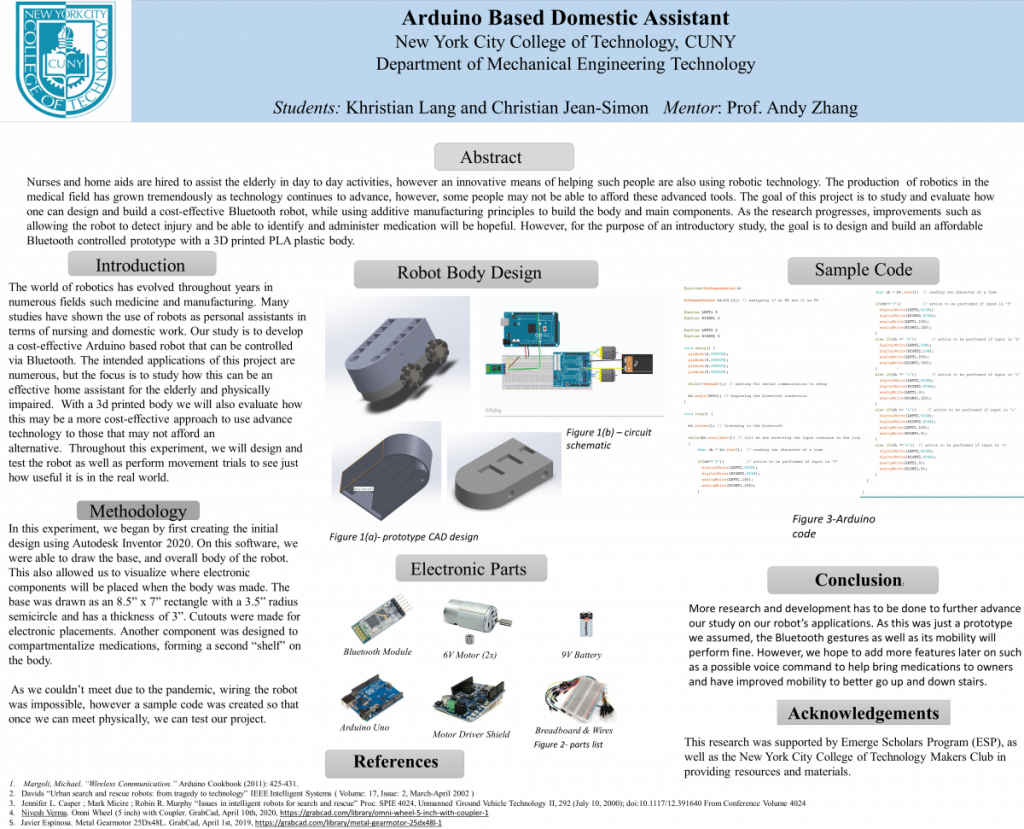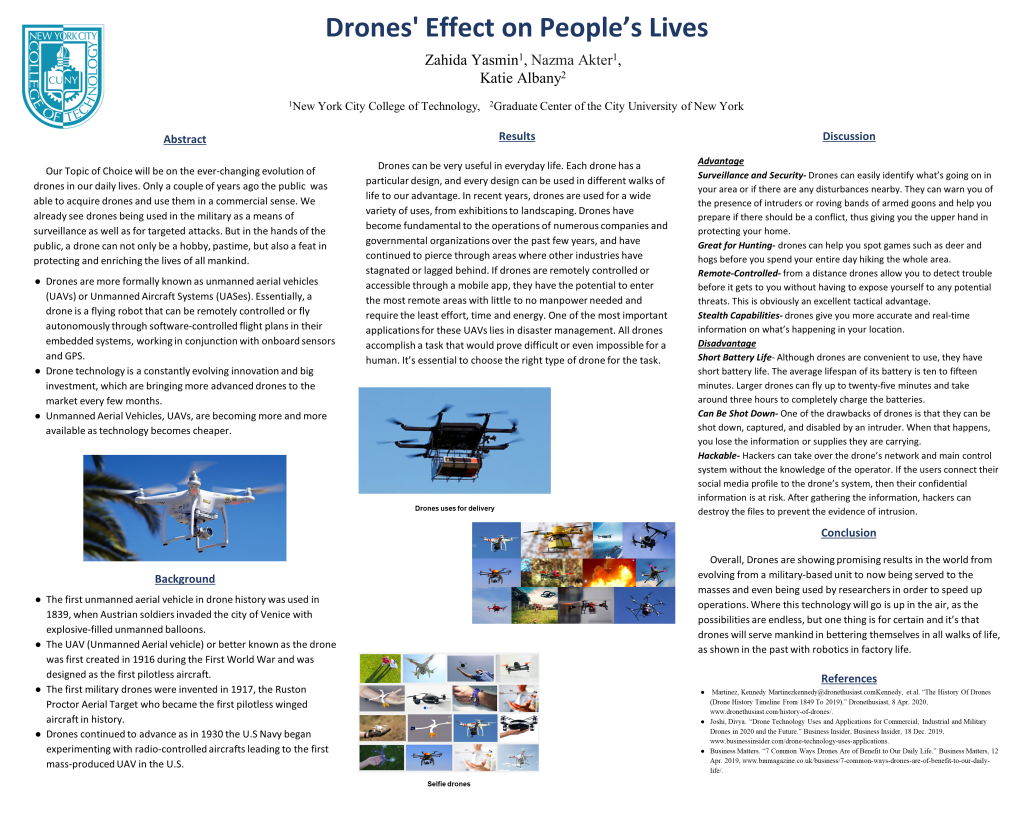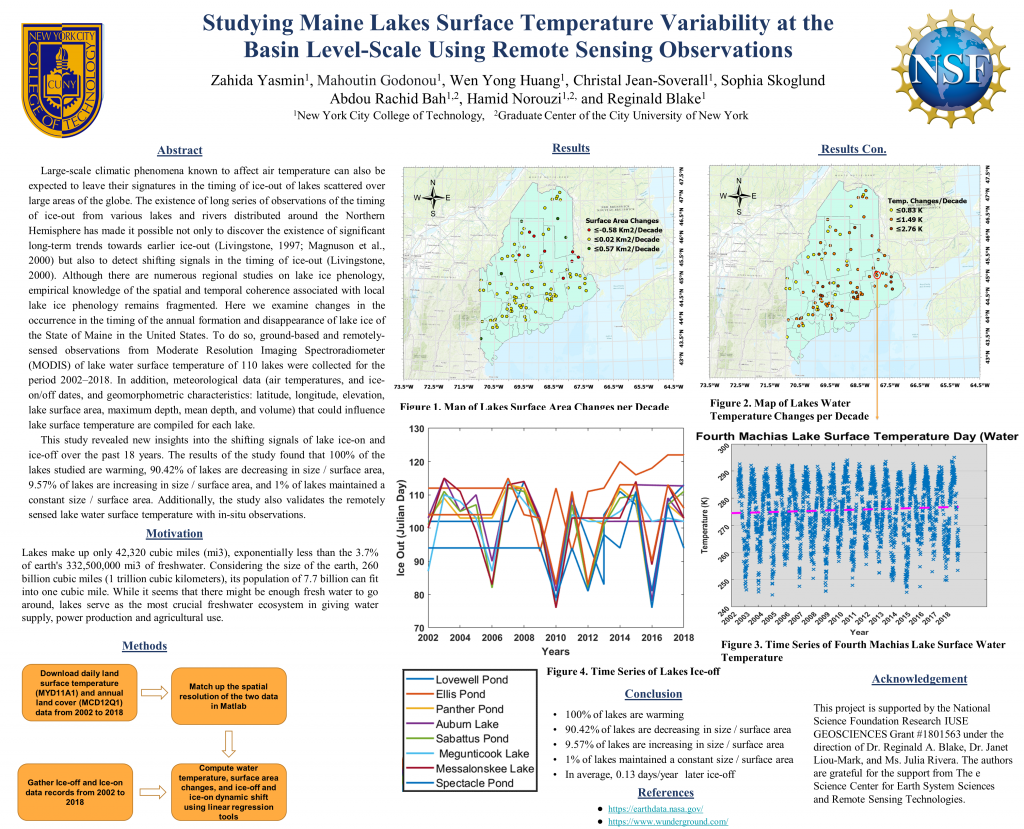This study focused on the design of a Bluetooth robot that can serve as a domestic assistant for the elderly. In this experiment, we designed the body using CAD software and hope to 3D print the body using a material known as PLA plastic. This material we found to be strong and affordable enough to use for manufacturing. Through findings we were able to develop a sample code for the project and gather the necessary electronic components. Due to the current situation we were unable to collaborate in the physical assembly and testing, however we plan to advance our study.
Our research was to show how drones are useful in everyday life. People use drones for many things. We already see drones being used in the military as a means of surveillance as well as for targeted attacks. But in the hands of the public, a drone can not only be a hobby, pastime, but also a feat in protecting and enriching the lives of all mankind. As we can see from this, drones are now being used in farming life and will continue to grow much more to provide assistance, such as search and rescue operations or just the simplest thinking, such as being able to deliver your online shopping packages to your doorstep. In its first conceptualization, the drone has come a long way from a military surveillance tool to now an autonomous worker. Overall, drones are very useful, and fun to use. They make people’s life easier by assisting with many mundane things.
Our research performed data analysis on Maine lakes using remote sensing and in situ observations. The purpose of this study is to reveal new insights into the shifting signals of lake ice-on and ice-off and the changes of water temperature over the past 18 years. The methodology being used is to collect daily land surface temperature, annual land cover, and ice-off and ice-on data records from 2002 to 2018. Linear regression tools have been used to analyze data and to obtain lake surface water temperature, surface area changes per decades for 110 lakes as well as the shifting dynamic of ice-off and ice-on for 9 lakes. Results show that 100% of the lakes studied are warming, 90.42% of lakes are decreasing in size, 9.57% of lakes are increasing in size, and 1% of lakes maintained a constant size. Additionally, there is an average of 0.13 day/year of later ice-off.
Hello everyone! My name is Xiaoqing Wu, and my teammate is Daanial Ahmad. Our mentor is Dr. Nan Li and Dr. Lin Zhou. We are all from the Department of Mathematics, New York City College of Technology. Our project title is Using data mining to identify the most
influential factors in training results. Data Science is used as a tool to find hidden facts in the data. We want to find out what factors such as ‘AGE’, ‘TAX’, ‘PER-CAPITA INCOME’ contribute the most to housing prices.
By applying the Lasso Regression (a Data Mining Technique) on the data set of “Boston Houses
Prices”, we successfully identified six significant factors which contributed the most to the prices of houses and those inputs are as follow:
(i) CRIM-per capita crime rate by town
(ii) ZN- proportion of residential land zoned for lots over 25000 sq. Ft
(iii) CHAS-Charles River Dummy Variable
(iv) RM- Average number of rooms per dwelling.
(v) Black- proportion of black by town
(vi) LSTAT-Lower status of population
Our research aims to perturb the usual and the unusual photosynthesis that pineapple has kept maintained for millions of years during plant evolution. Experiment was done by injecting Gadolinium contrast media into pineapple, which could share an electron from its ring structure to biochemical reaction centers and affect electron transfer during photosynthesis. Introduction to photoelectric absorption in Figure 1 demonstrates the different elements (k-edge) that represent the innermost strongest electron binding energy, which makes it possible for x-ray absorption. In Figure 2, we took the x-rays of the pineapple using the radiographic technique 45 kVp and 5 mAs, which were performed with an hour and a half difference between the procedures. The purpose of the delay to see the movement and diffusion of Gd contrast inside the pineapple can be observed on a second image (Figure 3). In Figure 4, we tried to measure the area of contrast spread in pineapple that was computed per hour diffusion rates along major and minor axes of elliptical iodine spots. Observations show that the minor axis shrinks while the significant axis enlarges.
In this research, we looked at the value of the radiographic shields in a few different studies to determine its efficacy in protecting the patient for hip x-ray exams. Recently, some radiographic departments are opting to not use lead shields in exams.We felt it pertinent to check if there is a benefit or detriment to the practice of shielding, one of the first things they drill into us as rad tech students. We hypothesized that shielding the patient indirectly leads to more dosage and our analysis of various studies confirmed this. The goal of this project would be to offer a conclusive position on the necessity of the shield in the radiological environment, and further influence future guidelines on whether it should be applied in the case of hip/pelvic anatomy.
The “Land Surface Temperature Analysis and Applications” has been continuously conducted for over 5 years. The objective of this project is to gather and process critical information on the LST (Land surface temperature) of urban areas to contribute to a wide range of environmental studies. This data is collected using thermal satellite images, a thermal imaging camera enabled drone, hand-held thermal cameras and a Flux tower. GOES-R and Landsat data is already commonly used but is greatly refined by comparing it with in-situ data. A more well-rounded view of LST data is our goal.
Climate change refers to the significant, long-term changes in the global climate. The global climate is the connected system of sun, earth and oceans, wind, rain and snow, forests, deserts and savannas, and everything people do. Global warming is the slow increase in the average temperature of the earth’s atmosphere because an increased amount of heat from the sun is being trapped in the earth’s atmosphere and not radiated out into space.In this paper we examine the issues related to climate change and suggest some plausible solutions to these issues. Climate change has created many issues all over the world, but we focus on New York for our project.
The goal of this project was to create 47 x 47 x 47 Rubik’s cube. We first started with deconstructing a regular 3x3x3 Rubik’s cube. Then, we looked online for 3-D printable files called STL files for a 5x5x5 cube. We printed and manually shaved and filed each piece to be put together. Once assembled, we looked to print 7x7x7 cube parts to calibrate the printer and make sure it was printing properly. From there, we moved up to our target 47x47x47 cube. Although it’s possible to print out all the pieces of a 47 x 47 x 47 piece puzzle, assembling all the pieces into one giant Rubik’s cube go fill up a whole office. This was the hard part because we couldn’t find the STL files for these dimensions. This would mean we would have to model each component and design them ourselves on CAD/CAM design software. Sam was partial to SolidWorks since he’s had some experience with it in the past. However, this proved to be quite an undertaking and after our collaboration was cut short due to the covid-19 pandemic, we were not able to complete the files and send it to the final printing phase.











